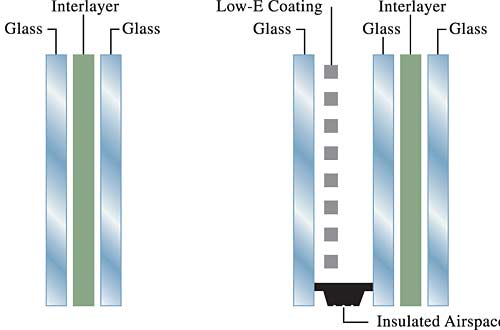New Glass Technologies Improve Performance of Architectural Glass
Solar Heat Gain Coefficient
The solar heat gain coefficient (SHGC) measures how well a product blocks heat caused by sunlight. SHGC is expressed as a number between 0 and 1. The lower a window's solar heat gain coefficient, the less sun-induced warmth it transmits into a building or house.
According to the U.S. Department of Energy, the solar heat gain coefficient of clear double-strength glass is 1.0. Glass with a solar heat gain coefficientt of 0.5 transmits half of that solar energy, and glass with a solar heat gain coefficient .75 transits three-quarters of that let through by clear double-strength glass. As the measure of effectiveness of blocking sun and heat, the shading coefficient is what drives air-conditioning loads. The lower the number, the more solar heat it resists, and the lower the cooling costs. Low SHGC ratings are most important in southern regions where outside temperatures are hot and cooling costs are traditionally high.
Visible Transmittance
Visible transmittance (VT) measures how much daylight comes through a window. VT is also expressed as a number between 0 and 1, and correlates directly with the percentage of light passing through the glass. In other words, a product with a .66 VT rating means that 66 percent of visible light is transmitted through the glass. The higher the VT, the more daylight is transmitted. A high VT is desirable to maximize the amount of daylight entering the occupied spaces. The more daylight entering a home or building, the greater the opportunity to reduce electric lighting.
Â
Air Leakage
Cracks in the window assembly cause heat to enter and leave the building unchecked. Air leakage is measured in terms of the air that passes through a given unit area of window, such as 5 cubic feet of air passing through 0.5 square feet of window assembly. The lower the value, the less air will unintentionally pass through.
Condensation Resistance
How well a fenestration product resists the forming of condensation on its interior surfaces is its condensation resistance (CR). The higher the CR rating, the better that product resists condensation. CR is expressed as a number between 0 and 100.
Window Technologies for Energy Performance
All of the energy-efficiency parameters discussed above are affected by the various components of a window: glass panes, low-E coatings, inert gas fills, edge spacers and frame materials. At their most effective, and in the proper climate and arrangement, these components lead to improvements in solar control, thermal comfort and energy savings.
Glass Layers
Standard single-pane glass has very little insulating value. Before the 1980s, a window's energy performance was improved primarily through the addition of glass panes, on the premise that double pane glass, in which two panes of glass enclose air space between them, has twice the insulating power of a single pane of clear glass. The trapped layer of air between the two panes creates the insulator that prevents warmth from escaping or entering the structure. Because the inner pane does not come into contact with the cold outside air, it stays warmer than the outside pane. Double pane windows can also insulate sound and eliminate condensation if the air space contains a moisture absorbing chemical.
Â
|
Â
Air Space
The depth of the air space between the glass panes will also affect energy performance: Spaces that are either too wide or too narrow tend to have higher U-values. Thicker air spaces insulate more effectively than thinner air spaces-up to a point. The optimal air space for energy performance is 1/2-inch, which translates into a 3/4-inch insulating glass unit.
Gas Fills
By substituting a denser, lower-conductivity gas such as argon for the air in a sealed insulated glass window, heat loss can be reduced significantly. Argon is much denser than air, and has a lower thermal conductivity, resulting in lower heat transmission between the panes of glass, and providing even more insulation for double pane windows. Many major window manufacturers offer argon-gas fill as an option. Other gases that are being used in windows include carbon dioxide (CO2), krypton (Kr), and argon-krypton mixtures.










